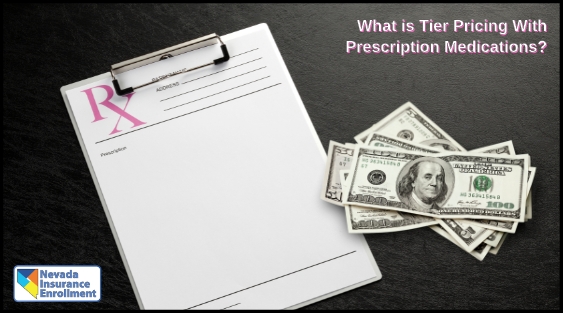Understanding How Drug Tiers Affect Your Wallet
Have you ever wondered why the amount that you pay at the pharmacy counter varies so much depending on the prescription that you’re filling? Generics, certain brand name prescription drugs and even some types of medications can all have wildly different coverages. In most cases, what you pay for a drug is dependent on your insurer’s tier pricing.

What Are Drug Tiers?
Your health insurance company’s formulary is a list of all the different drugs that their plans cover. Within the formulary, there are drug tiers. These tiers determine the level of coverage your prescription drug plan offers for a specific type of medication. Many prescription drug plans use a 4-tier system, while some insurers have an additional 5th or even 6th-tier system. Your insurer’s formulary and tier system are available on the company website or in the documents you received when you enrolled in your prescription drug plan.

Tier 1 Prescriptions:
This tier is usually the cheapest and generally includes generic medications.
Tier 2 Prescriptions:
This tier can include more expensive generic or less expensive brand name drugs that are preferred by your health insurance company. Just as your health insurance company provides better coverage for in-network healthcare providers, it provides better coverage for preferred drugs.
Tier 3 Prescriptions:
This tier includes brand name drugs that are not preferred by your health insurance company. These drugs are still covered, but you will likely pay more out of pocket than you would for a preferred drug.
Tier 4 Prescriptions:
This tier includes specialty drugs, such as those used for cancer treatment. These drugs have a much higher out-of-pocket cost.
Tier 5 Prescriptions:
This tier, which is not included in all prescription drug plans, includes highest cost specialty drugs.
Tier 6 Prescriptions:
With this tier many companies will use and not charge a copay at all, using a tier-6 medication for “maintenance medication”. You’ll need to check your plan details.
continued below ⇓
Recent Posts

Windshield / Glass Coverage
Windshield / glass coverage pays the amount of a covered glass loss, and as an added perk, it has a low deductible. Your insurer will cover the full costs of the repairs up to your policy limit, and as long as the costs of the damages don’t exceed your coverage limit, you’ll pay only your small deductible.




Term Life Insurance vs. Whole Life Insurance
Term life insurance policies will often have terms of one year to 30 years. Typically, the monthly premium (monthly payment) stays the same throughout the term of the policy. Whole life insurance provides coverage your whole life and it includes something called “cash value”. Think of it like a mini savings account attached to the policy.




Rental Reimbursement vs. K4 or K5 Coverage
Rental reimbursement would reimburse you for either your daily rental charges or your policy limit, whichever is less. It can be used after any covered collision or comprehensive loss (assuming you carry collision and comprehensive coverage). K4 and K5 coverage can also help with post-accident “loss-of-use” costs.
Health Insurance Quotes
2). Online Quote
3). In Person
4260 W. Craig Road #150-A
N. Las Vegas, NV 89032
Why Is Tier Pricing Used?
The primary purpose of tier pricing is to help health insurance companies manage their costs. In most cases, the drugs listed on a plan’s formulary are both effective and the most economically priced for treating a condition. To promote the use of generics or more cost-effective brand name drugs, health insurance companies may cover a larger portion of the costs for Tier 1 and Tier 2 drugs.
Understanding Tier Pricing Can Help You Save Money
Understanding your drug plans’ formulary and tier pricing and knowing what to expect at the pharmacy counter can help you save a lot of money on your prescriptions.
After you’ve reviewed your drug plans’ tiers, talk to your doctor about what conditions you’re currently receiving treatment for and what medications you are on. Your doctor can help you find the most cost-effective prescriptions that will provide effective treatment for your conditions. Additionally, in some but not all cases, generics may be substituted for brand name drugs, helping you pay the lowest price available.
continued below ⇓
Search This Website
Most Popular Pages
By page visits (this month)
#1) Health Insurance Subsidy Chart
#2) Health Insurance
#3) Health Insurance WITH a Subsidy
#4) Insurance Blog
#5) Request a Quote
Share Your Insurance Plans’ Formulary with Your Doctor
You have every right to share your insurance plans’ formulary with your doctor. Be pro-active in your own out of pocket costs. You and your doctor could converse about lower tiered medications your insurance plan formulary covers, to see if the medication could be the right medication for you, along with saving you money on your monthly medication costs. You should also speak with your broker about your medications BEFORE you purchase a health plan to see if there is a lower tiered plan offered. Important to ensure your doctor also takes the plan.
Nevada Insurance Enrollment Is Here to Help
Understanding how health insurance companies cover different types of drugs can be confusing. At Nevada Insurance Enrollment, our health insurance agents are here to help you find an insurer that will cover your prescriptions and help save you the most money. Contact us today to discuss your options.
Top 5 Most Popular
By page visits (this month)
#1) Health Insurance Subsidy Chart
#2) Health Insurance
#3) Health Insurance WITH a Subsidy
#4) Insurance Blog Posts
#5) Request a Quote
Recent Posts
No Results Found
The page you requested could not be found. Try refining your search, or use the navigation above to locate the post.